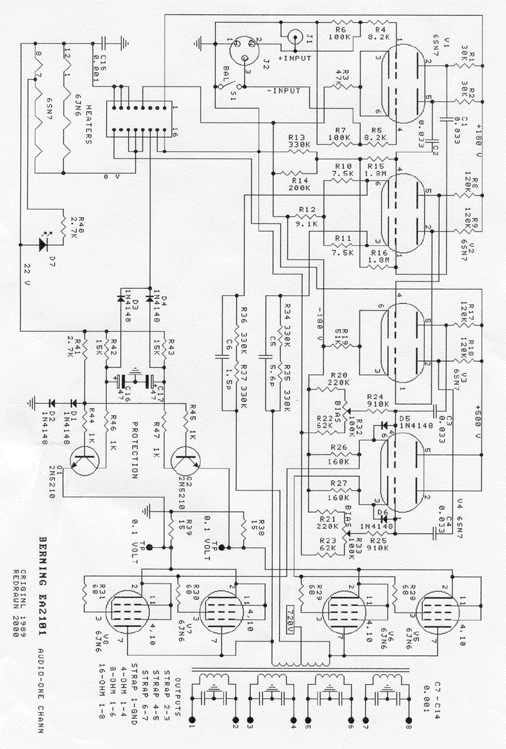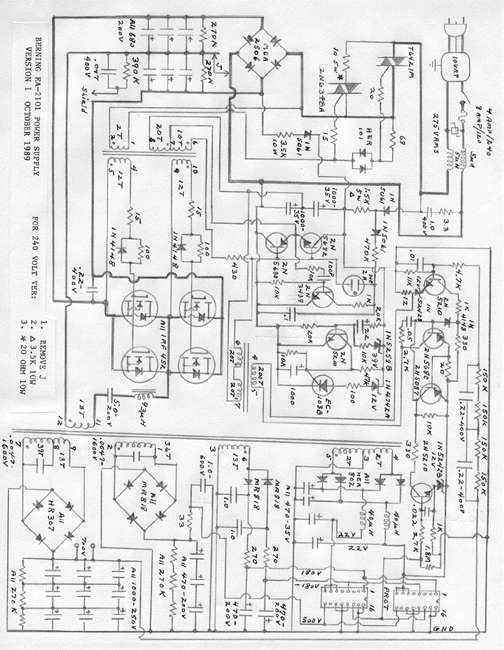EA-2101 Amplifier
Tube amplifier. Resonant power conversion technology.
Description: Vacuum-tube stereo amplifier, with transformer-coupled output stage. Power output: 100Wpc (20dBW), both channels driven, 30Hz-15kHz, at less than 2% THD. Frequency response: 4Hz-40kHz, -3dB, at 1W. Sensitivity: 800mV RMS for full power. Input impedance: 100k ohms. S/N ratio: 80dB, DC-1MHz; 100dB, 20Hz-20kHz.
Dimensions: 19" W by 5.25" W by 17.25" D. Weight: 40 lbs.
Price: $4290 (1992); no longer available (2003). Approximate number of dealers: 20. Warranty: two-year limited warranty against defects in material and workmanship.
EA-2101 Reviews
EA-2101 reviewed by Absolute Sound Magazine, vol. 80, June 1992
"If the Berning's soundstage is wide, deep, and filled with stable images, even more impressive is its ability to present detail-to make subtle aspects of performances audible, and previously obscure details recognizable. ... The point is that the Berning starkly revealed the phenomenon."
EA-2101 review in Stereophile Magazine by Dick Olsher, September 1992
"The EA2-150 was a copy of nothing; it represented an original and sophisticated design statement. Features such as variable feedback control and digital automatic bias adjustment were well ahead of their time. Dave symbolizes for me the quintessential high-end designer: someone with a glint in his eye who pushes the art forward because of the desire to uncover the truth. Of course, the guy wants to make money, but this is secondary to the creative process. The art is not driven by business. You wouldn't go up to Van Gogh and say: paint me a $299 or a $499 painting. That's low-fi. Instead, allow the artist to express himself freely with a complete palette on a large canvas. If the result costs five kilobucks, so be it. No one has ever sold a ton of $5k amps, but that wasn't the point in the first place. After experimenting with hybrid circuits, Berning settled down to using nothing but tubes; the EA-2101 represents his latest thinking on amplifier design. ...the Berning is capable of conveying an intensely musical experience, with soundstage transparency and dynamic bloom that rival those of any amp out there. Its bass balance nicely complemented the dynamic speakers I used it with. The Berning can also generate quite a punch at the low end, though its bass extension is somewhat restricted by solid-state standards. When it's sitting pretty, the Berning is a lot of fun. It's not a ponderous, fuzzy teddybear of an amp, a la the stock Dynaco Mk.III; its quickness and articulation dispel that notion instantly. The midrange is lucidly transparent, so that spatial outlines are focused palpably within the confines of the soundstage. Its lively nature, however, will dictate the sort of choices you make at the front end; such as phono cartridge. Your audio world will surely revolve around this amp. It has the potential of becoming the cornerstone of one hell of a system."
Berning interview with Ken Kessler, Stereophile Magazine, Vol.11 No.7, July 1988
EA-2101 Support
The failure prone parts in the EA-2101 are the four 150K resistors in the feedback sensing. Early versions used carbon film resistors that tended to increase in value, or go open completely, causing the output voltage of the power supply to increase until something else failed. Later versions of the amp used 1 W metal film resistors which have not shown failures. Any amps that have been returned to Berning for any kind of service have had these resistors changed. When this amp is serviced, the 700 volt output of the power supply should be checked. If it is high, more than 720 volts, these resistors should be checked.
Related failures caused by over voltage are the capacitor bank, voltage-equalizing resistors, and the HR307 diodes.
Bias measurements can be made by measuring across the 15 ohm resistors that are mounted along the front edge of the audio boards. These can be accessed via holes in the bottom of the chassis, and the correct voltage is 100mV. This amplifier should be able to deliver at least 100 watts per channel.


|
© 1974-2024 The David Berning Company
|
| |